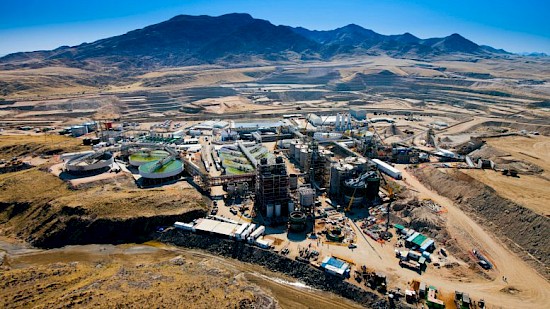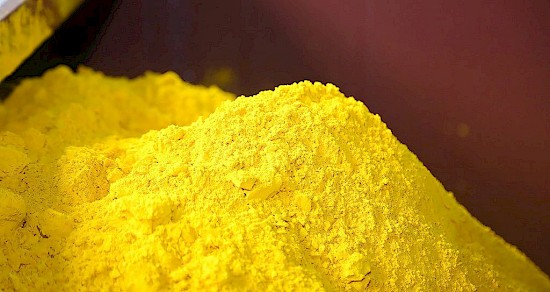 Blue Sky Uranium – Uranium market gathers momentum – towards a supply shortfall
Blue Sky Uranium – Uranium market gathers momentum – towards a supply shortfall

Paladin Energy’s Langer Heinrich uranium mine in Namibia. Credit: Paladin Energy
BY: DAVID A. TALBOT FEBRUARY 23, 2023
After a dozen years in the doldrums, uranium prices are on the rise, supported by real growing demand and support for nuclear power, as well as geopolitical concerns.
While in the recent past, support for nuclear power was based on environmental considerations as well as its ability to provide reliable and cheap baseload energy, Russia’s invasion of Ukraine shifted the geopolitical landscape from these considerations to one of energy security. Western government policies have pivoted in response and the sector is gaining momentum. Uranium prices, on the rise for the past four years, have accelerated, and perhaps as importantly, utilities are returning to long-term contracting.
Rising uranium demand and diminishing secondary supplies have spurred an increase in production. Rising long term prices and increased contract volumes are needed to provide the necessary price incentive for uranium producers to bring production back online or start up new projects. That said, uranium supplies remain tight and further price appreciation is anticipated. Mine supply is forecast at 143 million lb. U3O8 versus 181 million lb. of demand for 2023 by UxC, leaving a notable gap in mine supply that must be filled by declining secondary supplies.
Geopolitics
Nuclear power and uranium markets are heavily impacted by geopolitical concerns. This is largely due to Russia’s influence over the nuclear fuel (uranium, conversion, enrichment) and gas supply chains. The war has contributed greatly to Europe’s soaring power and fuel prices, causing some countries to accelerate new nuclear power plants (France, Poland) and has reversed or at least stalled closure plans in others (Germany, Belgium). Bloomberg noted that the EU has spent an additional $1 trillion on energy since the war began, impacting businesses and consumers. As the war drags on, we expect that existing nuclear utilities will scramble to cover their uranium requirements. Security of supply concerns might overshadow economics over the next few years, such that we might see additional funding of domestic nuclear programs, R&D, and uranium industry support.
Support for nuclear power is also growing within the United States and European Union, and elsewhere. Energy security of supply and environmental considerations are changing government policy and investor sentiment. Policy decisions by governments over the last couple of years has started to translate into new nuclear reactor announcements, builds, life extensions and the cancellation of some closures. This is driving real nuclear power demand growth and higher uranium prices that might help us emerge from a dozen years of low uranium prices.

Uranium yellowcake concentrate. Credit: Kazatomprom
In the U.S., the 2021 Infrastructure Bill and 2022 Inflation Reduction Act have provided funding, investment tax credits and loan guarantees in support of nuclear energy. Premature shutdowns have ceased, and the reopening of closed plants is even being considered. We estimate that 1.1 million lb. of U3O8 worth US$68.3 million and minor fuel services were purchased within the initial US$75 million round of buying by the U.S. Uranium Reserve. Five uranium companies received uranium at an average price of US$62 per lb. Canada has also committed $1 billion towards small modular reactors (SMR) thus far, and four reactor lives are to be extended.
Globally, China dominates the narrative as reactor builds are accelerating potentially to eight to-10 new reactors per year. Its mid-term goal is for a world-leading fleet of 150 operating reactors, 50% more than the U.S. South Korea has reversed policy and plans to achieve 33% nuclear with its energy mix by 2030. Japan, which is particularly impacted by LNG imports and prices, is striving for faster reactor restarts and longer life extensions in response to the Russian invasion. It plans to increase its operating reactor count from 10 to 17 by mid-2023, and ultimately to 35, including two new builds. India continues to look to expand its fleet of 22 reactors with eight under construction and 12 planned. Other developing nations seeking nuclear power include Bangladesh, Egypt, Turkey, Philippines and Indonesia.
Production to fall short
Uranium production is on the rise, but a gap remains. Production is expected to continue to rise by 8% this year to 143 million lb. from 132.5 million lb. However, that will fall short of expected demand of 181 million lb. U3O8,, despite planned restarts of several projects (Peninsula Energy‘s [ASX: PEN] Lance, Ur-Energy’s [TSX: URE] Lost Creek, and EnCore Energy’s [TSXV: EU] Rosita in the U.S. and Boss Energy’s [ASX: BOE] Honeymoon in Australia), the continued ramp up of Cameco’s (TSX: CCO; NYSE: CCJ) McArthur River in Saskatchewan and a 6% increase in Kazakh production. African projects are being given a new look in light of elevated geopolitical risks, with Paladin Energy (ASX: PDN) and China Nuclear Corp.’s Langer Heinrich in Namibia anticipated to return to production next year, and Global Atomic’s (TSX: GLO) Dasa in Niger, Lotus Resources’ (ASX: LOT) Kayelekera in Malawi, GoviEx Uranium’s (TSXV: GXU) Madaouela in Niger and Aura Energy’s (ASX: AEE) Tiris in Mauritania all being advanced. Despite this growth, UxC forecasts a uranium supply deficit of 13 million lb. this year, which will likely be filled through commercial inventory drawdown. Deficits will persist, but might shrink in the 2024-2025 period, after which U3O8 supply deficits are expected to increase with a cumulative production gap of roughly 345 million lb. anticipated by 2030.
Despite potential for higher prices, production challenges and uncertainties remain for miners, including supply chain issues, permitting and funding requirements, and overly optimistic production estimates and development timelines. However, the long period of low uranium prices has had a major impact on the uranium mining industry. Current supply remains insufficient to meet future reactor requirements and the challenges outlined above may push some projects off into the future. Further discoveries are required to maintain supply, particularly since there was a trend towards the development of smaller deposits and lower grades last cycle. The negative impact of grades, and inflation means that future uranium prices will have to account for higher expected production costs.
Secondary supplies, which plugged the 55 million lb. gap between mine production and demand in 2022, are also anticipated to tighten. Those supplies will likely fill the 38 million lb. gap this year, accounting for 21% of total supply. Further commercial inventory drawdowns will take place as spot market supplies are less available, but it won’t be as dramatic. It is also likely that governments and western enrichers will reduce sales, and underfeeding will decrease.
Real demand driving prices
Spot uranium prices have risen US$48 per lb. at the end of last year from US$42 per lb. at the end of 2021 and US$30 per lb. at year-end 2020. After peaking at US$63 per lb. in April 2022 on speculation of Russian sanctions, the current spot price is US$50.50 per lb., up 5% year-to-date. While we do believe that a war premium is built into pricing, we are more relieved that real uranium demand is driving up long term prices. We believe spot price drivers for 2023 include renewed investor interest in uranium and ongoing purchases by Sprott Physical Uranium Trust (SPUT), added discretionary buying by utilities, and a weaker US dollar that could make uranium more attractive in foreign exchange terms.
Volatile spot market and geopolitical concerns have accelerated nuclear utilities’ return to contracting, and the strengthening term market is exactly what the doctor ordered. Long-term prices have trended upwards over the past four years, increasing 23% from US$33 per lb. to US$40.50 per lb. by the end of 2021, and 26% to US$51/lb over 2022, the largest gains since 2007. Term prices are up 2% year-to-date to US$52 per lb.
Last year, 2022 term contracting rose 58% to 113.1 million lb., versus an average of 72.6 million lb. per year over most of the past decade according to UxC, to the highest levels since 2005/2006. The average contract size was higher than past years as well. Contracting by U.S. utilities rose 54% to account for 61% of the term trading volumes, and mostly for the 2023-2029 period. Non-U.S. utility contracts weren’t as large but often had longer periods. Term contracts are now often market-related and incorporate base-escalated prices. Uranium producers remain the primary sellers at 86% of volume, up from 64-65% in prior years. Intermediary sales fell from 22% to 3% as the number of carry trades fell considerably.
Even with increased term contracting, uncovered reactor requirements total 1.3 billion lb. U3O8 through 2030. Over the past five years, roughly 430 million lb. has been contracted, with Cameco alone accounting for 147 million lb. over the last 14 months. This is well short of the 775 million lb. used by nuclear reactors during the same period. The lack of investment in uranium mining and exploration since Fukushima have many concerned about supply sources. Furthermore, secondary supplies have declined, and spot market trading has declined as financial entities and uranium companies have entered the market and removed material.
The Russian invasion has been a major factor in uranium price increases and higher contract volumes by both U.S. and non-U.S. utilities. This trend is likely to continue as Cameco has already announced 80 million lb. worth of contracts in 2023. While existing shipments from Russia currently have no trade restrictions, there have been threats of trade actions by the U.S., EU, and Canada, and even threats from Russia to cut off supply. Other ongoing challenges include inflation, supply chain constraints (lack of access to uranium supplies and/or conversion and enrichment services), transportation, rising interest rates and foreign exchange risk.
Declining stocks
Production curtailment over recent years due to low prices and Covid-19 led to a reliance on uranium inventories. Stocks have declined in the west, while buying takes place in the east. Government stockpiles have seen limited selling. Demand by financial entities and several uranium producers has also removed millions of pounds from the spot market.
Another positive for mine production demand is a shift to overfeeding from underfeeding for enrichment companies, which have been spending money on further enrichment of their existing uranium inventories (underfeeding). This excess material was then sold into the market. With conversion demand rising, we are seeing more overfeeding. That means more uranium consumption and less time spent on converting supplies and stockpiles with lower tails assays. This means more uranium from the mines that have a higher proportion of U-235 are sent through the enrichment plants more quickly.
Best,
Michael Winter
The Northern Miner
Glacier Media (GVC-T)
225 Duncan Mill Rd., Suite 320
Toronto, Ontario M3B 3K9
(416) 510 – 6772
(888) 502 – 3456 xt. 43723
[email protected]
www.northernminer.com
The Northern Miner Podcast






















